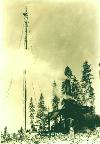


|

|
Legends are made of high climbing and what you see here is typical of what needed to be done in the days of wooden spar tree logging. Note the climber will up on this tree.
A tall straight tree was selected as a prospective spar pole. A climber would climb the tree cutting off the limbs as he went and finally topping the tree. A profound hazard of the job was conk rot. People tend to think of these large trees as all being sound solid wood. Well some of them were. You see fir trees tend to die from the inside out as the sap wood is the most durable, but if water gets into the heart of the tree through a broken limb or injury these trees would rot on the inside and become dangerously weak.
One of the things the climbers needed to determine was wether the tree was sound or not. As they climbed the tree the climbers traditionally carried a single bitted axe with them. They would thunk the tree with the hammer side of the axe every step of the way up the tree and listen for hollow spots. If the report from the the 'thunk' wasn't right, they looked for another tree.
The climbing spurs used by loggers are similar but much larger and longer than the spurs used by utility folks to climb utility poles. The more aggressive spurs were used because these trees had bark on them. A leather climbing belt didn't do the job either because it would not reach around the tree. High climbers used a rope that was suppose to be at least part cable so reduce the risk of accidentally chopping it off.
Once the tree was topped, then a pass block was hung in the top, and this brought up the rest of the equipment and rigging including guywires, blocks, and what ever was needed.
For information on types of rigging and carriages see those topics on the Iron Page.